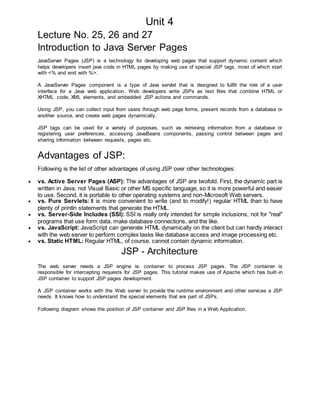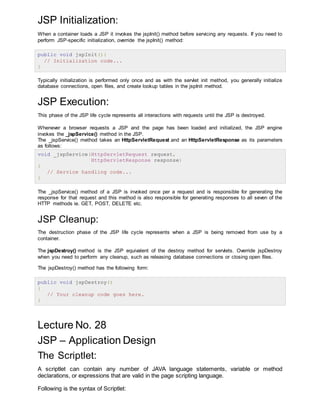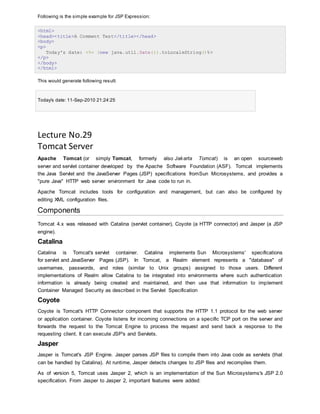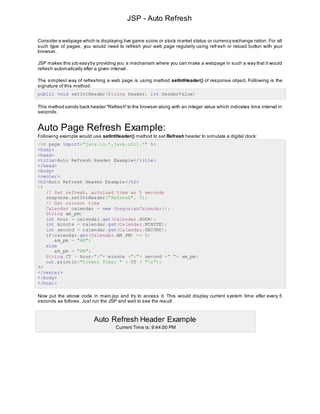The document discusses Java Server Pages (JSP) technology. It introduces JSP, describes how JSP pages are processed by the web server, and discusses key aspects of JSP including implicit objects, control flow statements, operators, and declaring variables and methods. JSP pages combine HTML/XHTML code with embedded Java code to create dynamic web content. The Java code in JSP is executed on the server to generate the HTML response sent to the client.




![<% code fragment %>
You can write XML equivalent of the above syntax as follows:
<jsp:scriptlet>
code fragment
</jsp:scriptlet>
Any text, HTML tags, or JSP elements you write must be outside the scriptlet. Following is the simple and first
example for JSP:
<html>
<head><title>Hello World</title></head>
<body>
Hello World!<br/>
<%
out.println("Your IP address is " + request.getRemoteAddr());
%>
</body>
</html>
JSP Declarations:
A declaration declares one or more variables or methods that you can use in Java code later in the JSP file. You
must declare the variable or method before you use it in the JSP file.
Following is the syntax of JSP Declarations:
<%! declaration; [ declaration; ]+ ... %>
You can write XML equivalent of the above syntax as follows:
<jsp:declaration>
code fragment
</jsp:declaration>
Following is the simple example for JSP Declarations:
<%! int i = 0; %>
<%! int a, b, c; %>
<%! Circle a = new Circle(2.0); %>
JSP Expression:
A JSP expression element contains a scripting language expression that is evaluated, converted to a String, and
inserted where the expression appears in the JSP file.
Because the value of an expression is converted to a String, you can use an expression within a line of text, whether
or not it is tagged with HTML, in a JSP file.
The expression element can contain any expression that is valid according to the Java Language Specification but
you cannot use a semicolon to end an expression.
Following is the syntax of JSP Expression:
<%= expression %>
You can write XML equivalent of the above syntax as follows:
<jsp:expression>
expression
</jsp:expression>](https://image.slidesharecdn.com/unit41-150321015514-conversion-gate01/85/Unit-4-1-web-technology-uptu-5-320.jpg)



![</html>
This would produce following result:
JSP Tutorial
JSP Tutorial
JSP Tutorial
Above example can be written using while loop as follows:
<%! int fontSize; %>
<html>
<head><title>WHILE LOOP Example</title></head>
<body>
<%while ( fontSize <= 3){ %>
<font color="green" size="<%= fontSize %>">
JSP Tutorial
</font><br />
<%fontSize++;%>
<%}%>
</body>
</html>
This would also produce following result:
JSP Tutorial
JSP Tutorial
JSP Tutorial
JSP Operators:
JSP supports all the logical and arithmetic operators supported byJava. Following table give a listof all the operators
with the highest precedence appear at the top of the table, those with the lowest appear at the bottom.
Within an expression, higher precedence operators will be evaluated first.
Category Operator Associativity
Postfix () [] . (dot operator) Left to right
Unary ++ - - ! ~ Rightto left
Multiplicative * / % Left to right
Additive + - Left to right
Shift >> >>> << Left to right
Relational > >= < <= Left to right
Equality == != Left to right
Bitwise AND & Left to right
Bitwise XOR ^ Left to right
Bitwise OR | Left to right
Logical AND && Left to right
Logical OR || Left to right
Conditional ?: Rightto left
Assignment = += -= *= /= %= >>= <<= &= ^= |= Rightto left
Comma , Left to right](https://image.slidesharecdn.com/unit41-150321015514-conversion-gate01/85/Unit-4-1-web-technology-uptu-9-320.jpg)
![Lecture No. 33
Declaring variables and methods
The Scriptlet:
A scriptlet can contain any number of JAVA language statements, variable or method
declarations, or expressions that are valid in the page scripting language.
Following is the syntax of Scriptlet:
<% code fragment %>
You can write XML equivalent of the above syntax as follows:
<jsp:scriptlet>
code fragment
</jsp:scriptlet>
Any text, HTML tags, or JSP elements you write must be outside the scriptlet. Following is the simple and first
example for JSP:
<html>
<head><title>Hello World</title></head>
<body>
Hello World!<br/>
<%
out.println("Your IP address is " + request.getRemoteAddr());
%>
</body>
</html>
JSP Declarations:
A declaration declares one or more variables or methods that you can use in Java code later in the JSP file. You
must declare the variable or method before you use it in the JSP file.
Following is the syntax of JSP Declarations:
<%! declaration; [ declaration; ]+ ... %>
You can write XML equivalent of the above syntax as follows:
<jsp:declaration>
code fragment
</jsp:declaration>
Following is the simple example for JSP Declarations:
<%! int i = 0; %>
<%! int a, b, c; %>
<%! Circle a = new Circle(2.0); %>
JSP Expression:
A JSP expression element contains a scripting language expression that is evaluated, converted to a String, and
inserted where the expression appears in the JSP file.
Because the value of an expression is converted to a String, you can use an expression within a line of text, whether
or not it is tagged with HTML, in a JSP file.](https://image.slidesharecdn.com/unit41-150321015514-conversion-gate01/85/Unit-4-1-web-technology-uptu-10-320.jpg)











